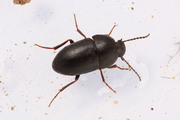Підтримуємо Вільну Україну
 We Support Free Ukraine
We Support Free Ukraine

Biodiversity Map
Taxa

Crypticus — subordinate taxa:
Taxon count: 1
-
Arthropodaphylum
Click to switch
to select orders
and filters > -
Hexapodasubphylum
Click to switch
to select orders
and filters > -
Insectaclass
Click to switch
to select orders
and filters > -
Coleopteraorder
Click to set
as the main taxon
and as a base
← of the left panel > -
Polyphagasuborder
Click to set
as the main taxon
and as a base
← of the left panel > -
Cucujiformiaseries
Click to set
as the main taxon
and as a base
← of the left panel > -
Tenebrionoideasuperfamily
Click to set
as the main taxon
and as a base
← of the left panel > -
Tenebrionidaefamily
Click to set
as the main taxon
and as a base
← of the left panel > -
Diaperinaesubfamily
Click to set
as the main taxon
and as a base
← of the left panel > -
Crypticinitribe
Click to set
as the main taxon
and as a base
← of the left panel > -
Crypticusgenus
Click to set
as the main taxon
and as a base
← of the left panel > -
Crypticussubgenus
Click to set
as the main taxon
and as a base
← of the left panel > -
Crypticus quisquiliusspecies
Click to set
as the main taxon
and as a base
← of the left panel >
PL
YES
name status: valid name
BioMap ID: 1021310
taxon code: 3953
taxonomy checked: YES
Data on distribution in Poland

Statistics
- Records: 685
- Publications: 66
- Collections: 22
- Publication authors: 72
- Illustrations (iconography): 1
- Photos (specimen/observation): 2
Taxon description
Gatunek rozprzestrzeniony od Wysp Brytyjskich, południowych prowincji Fennoskandii i Karelii aż do Hiszpanii, Włoch i Bałkanu północnego, wykazywany ponadto z Kaukazu, Syberii i Mongolii. W Polsce notowany z nielicznych stanowisk rozproszonych w różnych częściach kraju. Zasiedla tereny nizinne i pagórkowate. Występuje na suchych, nasłonecznionych miejscach piaszczystych pokrytych niską, skąpą roślinnością. Znajdowany pod kamieniami, w powierzchniowej warstwie gleby, pod szczątkami roślin, płożącymi się na ziemi roślinami. Chrząszcze spotykano od wiosny do jesieni, najczęściej w czerwcu i lipcu. Wykazują one dużą ruchliwość podczas ciepłych dni i przy słonecznej pogodzie bardzo szybko przebiegają od kryjówki do kryjówki, przypominając kształtem i ruchem niektóre gatunki z rodzajów Amara Bon. i Harpalus Latr. Larwy odbywają rozwój w glebie; przepoczwarczenie następuje w maju.
Illustrations
... browse
 Crypticus
Crypticusquisquilius
quisquilius
External data sources
- Ostatnie rekordy
-
1111211
 ⊡
⊡ Tenebrionidae: Crypticus quisquilius quisquilius, PL, Wyżyna Krakowsko-Wieluńska, Zesławice / Kraków, UTM DA35, 2008, leg. M. Józefczyk
Tenebrionidae: Crypticus quisquilius quisquilius, PL, Wyżyna Krakowsko-Wieluńska, Zesławice / Kraków, UTM DA35, 2008, leg. M. Józefczyk -
1111210
 ⊡
⊡ Tenebrionidae: Crypticus quisquilius quisquilius, PL, Pojezierze Pomorskie, Szczecin, UTM VV61, 1998, leg. R. Kondrat
Tenebrionidae: Crypticus quisquilius quisquilius, PL, Pojezierze Pomorskie, Szczecin, UTM VV61, 1998, leg. R. Kondrat -
1111209
 ⊡
⊡ Tenebrionidae: Crypticus quisquilius quisquilius, PL, Nizina Wielkopolsko-Kujawska, Kiszewo, UTM XU13, 2010, leg. M. Józefczyk
Tenebrionidae: Crypticus quisquilius quisquilius, PL, Nizina Wielkopolsko-Kujawska, Kiszewo, UTM XU13, 2010, leg. M. Józefczyk -
1076814
 ×
× Tenebrionidae: Crypticus quisquilius quisquilius, PL, Podlasie, Wysoczyzna Drohiczyńska, podlaskie, Siemiatycki, Mielnik, ad Mielnik, UTM FC39, 2016, leg. A. Lasoń
Tenebrionidae: Crypticus quisquilius quisquilius, PL, Podlasie, Wysoczyzna Drohiczyńska, podlaskie, Siemiatycki, Mielnik, ad Mielnik, UTM FC39, 2016, leg. A. Lasoń -
1076669
 ⊡
⊡ Tenebrionidae: Crypticus quisquilius quisquilius, PL, Podlasie, Nizina Podlaska, podlaskie, wysokomazowiecki, Sokoły, Jeńki, UTM FD27, 2016, leg. A. Lasoń
Tenebrionidae: Crypticus quisquilius quisquilius, PL, Podlasie, Nizina Podlaska, podlaskie, wysokomazowiecki, Sokoły, Jeńki, UTM FD27, 2016, leg. A. Lasoń -
1034754
 ⊡
⊡ Tenebrionidae: Crypticus quisquilius quisquilius, PL, Nizina Mazowiecka, mazowieckie, Warszawa, Warszawa, UTM EC07, 2015, leg. M.W. Kozłowski
Tenebrionidae: Crypticus quisquilius quisquilius, PL, Nizina Mazowiecka, mazowieckie, Warszawa, Warszawa, UTM EC07, 2015, leg. M.W. Kozłowski -
905129
 ×
× Tenebrionidae: Crypticus quisquilius quisquilius, PL, Nizina Mazowiecka, Warszawa, Włochy, UTM DC98 (Iwan et al. 2010, Iwan et al. 2012)
Tenebrionidae: Crypticus quisquilius quisquilius, PL, Nizina Mazowiecka, Warszawa, Włochy, UTM DC98 (Iwan et al. 2010, Iwan et al. 2012) -
905128
 ⊡
⊡ Tenebrionidae: Crypticus quisquilius quisquilius, PL, Pobrzeże Bałtyku, Koszalin, UTM WA70 (Iwan et al. 2010, Iwan et al. 2012)
Tenebrionidae: Crypticus quisquilius quisquilius, PL, Pobrzeże Bałtyku, Koszalin, UTM WA70 (Iwan et al. 2010, Iwan et al. 2012) -
904112
 ○
○ Tenebrionidae: Crypticus quisquilius quisquilius, PL, Roztocze, Ordynacja Zamojska, UTM FB40 (Tenenbaum 1913a, Iwan et al. 2012)
Tenebrionidae: Crypticus quisquilius quisquilius, PL, Roztocze, Ordynacja Zamojska, UTM FB40 (Tenenbaum 1913a, Iwan et al. 2012) -
904111
 ⊡
⊡ Tenebrionidae: Crypticus quisquilius quisquilius, PL, Beskid Wschodni, Przemyśl, UTM FA21, leg. T. Trella (Trella 1923c, Iwan et al. 2012)
Tenebrionidae: Crypticus quisquilius quisquilius, PL, Beskid Wschodni, Przemyśl, UTM FA21, leg. T. Trella (Trella 1923c, Iwan et al. 2012) - ... more
- Powiązane publikacje
-
Iwan D., Kubisz D., Tykarski P. 2012. Tenebrionoidea: Tenebrionidae, Boridae. Critical checklist, distribution in Poland and meta-analysis. Coleoptera Poloniae, 1, University of Warsaw – Faculty of Biology, Natura optima dux Foundation, Warszawa.
 selected pages
selected pages Show records
Show records -
Byk A. 2011. Wpływ sposobu przygotowania gleby na zgrupowania chrząszczy (Coleoptera) występujace na uprawach leśnych założonych na gruntach porolnych. Sylwan, 155(9):622-632.
 Show records
Show records -
Marczak D., Lasecki R., Mroczyński R. 2010a. Materiały do poznania rozmieszczenia chrząszczy z rodziny czarnuchowatych (Coleoptera: Tenebrionidae) w Polsce. Wiad. Entomol., 29(4):273-282.
 full text
full text Show records
Show records -
Jaskuła R., Przewoźny M., Melke A., Soszyńska-Maj A. 2010. Chrząszcze (Coleoptera). [In:] Jaskuła R., Tończyk G. (Eds.) Owady (Insecta) Parku Krajobrazowego Wzniesień Łódzkich. Park Krajobrazowy Wzniesień Łódzkich, Mazowiecko-Świetokrzyskie Towarzystwo Ornitologiczne, Łódź.
 Show records
Show records -
Iwan D., Kubisz D., Mazur M.A. 2010. The occurrence of Tenebrionidae (Coleoptera) in Poland based on the largest national museum collections. Fragm. Faun., 53:1-95.
 full text
full text Show records
Show records - ... more








